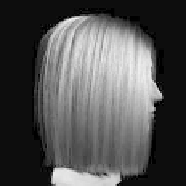Graphics Reference
In-Depth Information
(a) (b) (c)
Figure 8.67
Comparison of rendering methods using the dual scattering approximation: (a) path trac-
ing, for reference (7.8 hours); (b) offline dual scattering (5.2 minutes); (c) real-time dual
scattering (14 frames per second). (From [Zinke et al. 08] c
2008 ACM, Inc. Included
here by permission.) (See Color Plate XVII.)
general applicability that makes them likely to be applicable in rendering other
materials.
8.6 Recovering Details of Hair
It was shown in the papers described above that a good physically based hair
reflectance model, such as the Marschner model, coupled with a multiple scat-
tering rendering method is necessary to reproduce the appearance of real human
hair. However, this alone did not satisfy the demand for realistic rendering of
hair. Even with the refined hair reflection methods described in the previous sec-
tion, rendered results still seemed to lack a certain realism. This was especially
noticeable in applications for which the local detail was most important, such as
in movie close-ups. So the next problem was to improve the geometric model
of the individual strands. This kind of incremental pursuit of realism has been
common in the history of computer graphics. Another force driving the improve-
ment in hair models was the increasing prevalence of ray tracing in production
rendering that began around the year 2008. This generated more interest in the
geometric details of hair. In 2009, two methods emerged that largely met these
new demands for better geometry control while maintaining accurate color. Both
methods employed an image-based approach—they recovered the geometry of
hair from captured data of real hair.
8.6.1 A Fiber-Based Approach to Modeling Hair
A major advance in realistic geometric modeling of hair was presented in a paper
entitled “Capturing Hair Assemblies Fiber by Fiber” byWenzel Jakob, Jonathan T.










